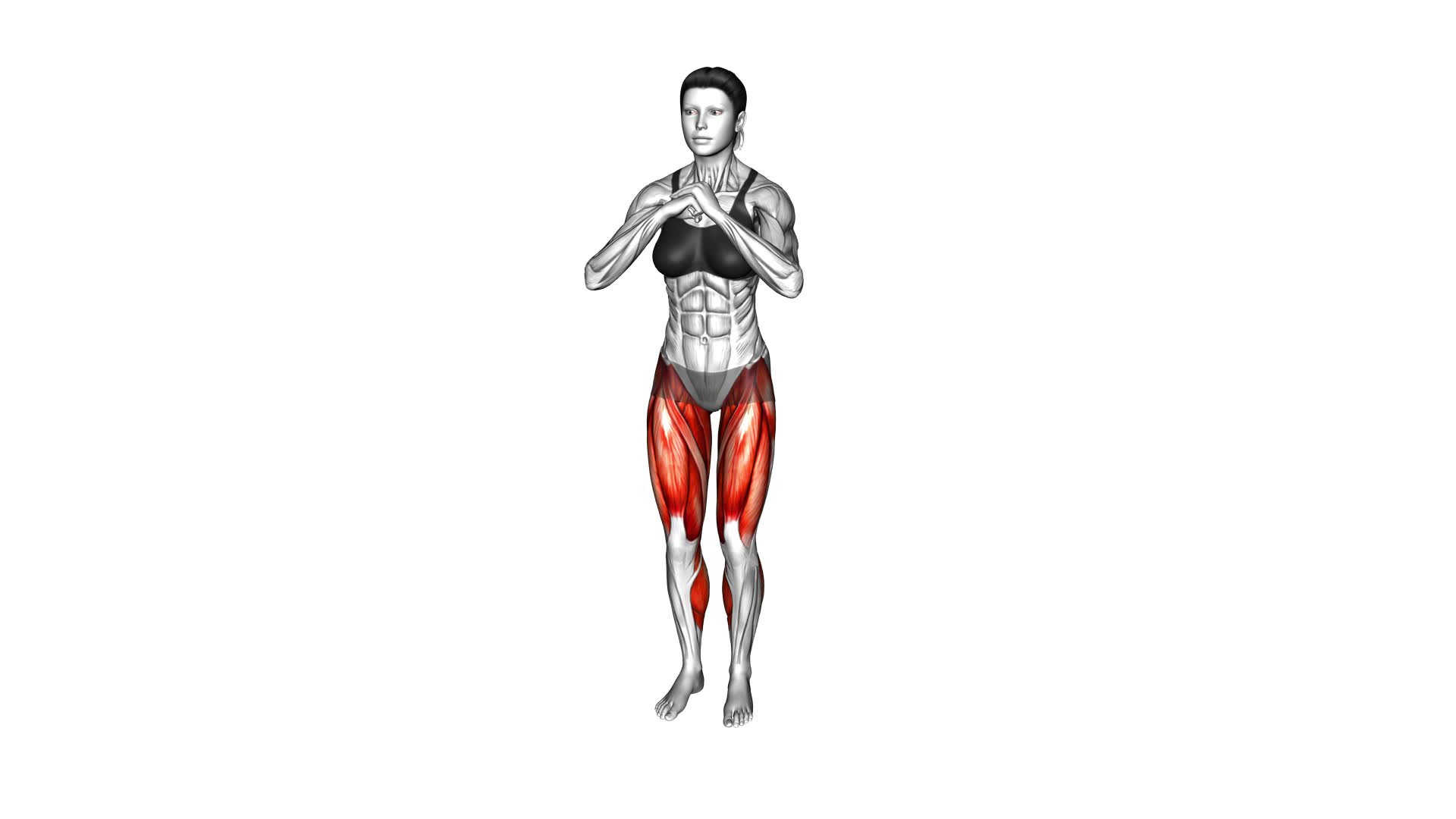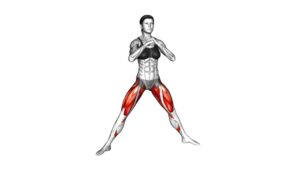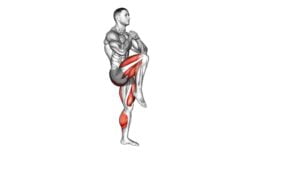Side Lunge (female) – Video Exercise Guide & Tips

Ready to tone your legs and strengthen your glutes? Look no further than the side lunge.
Watch This Exercise Video
In this video exercise guide, we'll show you how to perform side lunges correctly, along with tips to maximize your results. Don't let common mistakes hold you back – we'll help you avoid them.
Plus, we'll share variations and modifications, and provide helpful tips for a more effective side lunge workout.
Let's get started!
Key Takeaways
- Side lunges improve balance and reduce the risk of falls and injuries.
- Side lunges target the inner and outer thighs, quadriceps, hamstrings, and glutes.
- Proper form includes maintaining stable and aligned posture, keeping the knee in line with the toes, and a straight back.
- Modifications and alternatives include using support from a chair or wall, trying different lunge variations, and using dumbbells or kettlebells for added resistance.
Benefits of Side Lunges
You can experience several benefits from incorporating side lunges into your workout routine. Side lunges are a great exercise for improving balance and targeting the inner and outer thighs. By performing side lunges, you engage the muscles in your legs, including the quadriceps, hamstrings, and glutes. This exercise also activates the adductor muscles, which are responsible for moving your legs inward and outward.
Improving balance is one of the key benefits of side lunges. As you perform the exercise, you shift your weight from one side to the other, challenging your stability and coordination. This can help you develop better balance and control over your body, reducing the risk of falls and injuries.
Additionally, side lunges specifically target the inner and outer thighs. As you step to the side and lower your body into a lunge position, you engage the muscles in your inner thighs. This can help tone and strengthen these muscles, creating a more sculpted appearance. The outer thighs are also engaged as you push off and return to the starting position, providing a well-rounded workout for your lower body.
Incorporating side lunges into your workout routine is a great way to improve balance and target the inner and outer thighs.
Now, let's move on to the next section, where we'll discuss the proper form and technique for performing side lunges.
Proper Form and Technique
To ensure proper form and technique for side lunges, focus on maintaining a stable and aligned posture throughout the exercise. Start by standing with your feet shoulder-width apart and your toes pointing forward. Take a step to the side with your right foot, keeping your left foot planted on the ground. Bend your right knee and lower your body down into a lunge, ensuring that your knee stays in line with your toes and doesn't extend past them. Keep your back straight and engage your core muscles to provide stability. Push through your right heel to return to the starting position. Repeat on the other side.
To modify side lunges, you can use a chair or wall for support. Hold onto the chair or place your hand against the wall while performing the exercise to help with balance. This modification is especially useful for beginners or individuals with balance issues.
If side lunges aren't suitable for you, there are alternative exercises that target similar muscle groups. Some alternatives include lateral lunges, curtsy lunges, and step-ups. These exercises engage the glutes, quads, and hamstrings while providing a different range of motion.
Common Mistakes to Avoid
One common mistake to avoid when performing side lunges is allowing your knee to extend past your toes. This can put excessive strain on your knee joint and increase the risk of injury. To prevent this mistake, focus on keeping your knee in line with your toes throughout the movement. As you step out to the side, push your hips back and lower your body by bending your knee and hip. Make sure to keep your knee aligned with your second toe, and avoid letting it go beyond your toes. This will help to maintain proper form and technique, ensuring a safe and effective side lunge.
Another common mistake isn't maintaining a stable core. To avoid this, engage your core muscles by pulling your belly button in towards your spine and maintaining a neutral spine position throughout the exercise.
Variations and Modifications
For different ways to modify or vary the side lunge exercise, try incorporating different equipment or adjusting the range of motion. Side lunge variations and modifications can help you target different muscles and add variety to your workout routine.
One way to modify the side lunge is by using dumbbells or a kettlebell. Holding weights in your hands while performing the exercise will increase the resistance and challenge your muscles even more. This can be especially beneficial if you're looking to build strength in your legs and glutes.
Another modification you can try is adjusting the range of motion. If you find that the full side lunge is too challenging, you can start with a smaller range of motion by not lunging as far to the side. As you get stronger and more comfortable, you can gradually increase the range of motion until you're able to perform the full side lunge.
Additionally, you can incorporate a lateral raise into the side lunge to target your shoulders. While performing the lunge, lift your arms out to the sides and bring them back down as you stand up. This will engage your shoulder muscles and add an extra challenge to the exercise.
Tips for a More Effective Workout
Get the most out of your side lunge workout with these helpful tips.
First, let's address some common misconceptions. Many people believe that side lunges only target the inner thighs, but they actually work multiple muscle groups, including the quadriceps, hamstrings, glutes, and adductors. So, don't underestimate the effectiveness of this exercise.
To make your side lunge workout more effective, it's important to use proper form and technique. Keep your chest up, shoulders back, and engage your core throughout the movement. Take a wide step to the side, keeping your feet parallel and toes pointing forward. As you lower into the lunge, focus on pushing your hips back and bending your knees, ensuring that your knee doesn't extend past your toes.
In terms of equipment recommendations, it isn't necessary to use any equipment for side lunges. However, if you want to add resistance and increase the challenge, you can hold a dumbbell or kettlebell in front of your chest or use a resistance band around your thighs.
Remember to start with lighter weights or resistance bands and gradually increase as you become more comfortable and stronger.
Frequently Asked Questions
How Many Calories Can I Burn by Doing Side Lunges?
When it comes to burning calories, side lunges can be an effective exercise. By engaging multiple muscle groups, side lunges can help you burn calories and tone your body.
To properly perform a side lunge, start by standing with your feet hip-width apart. Take a big step to the side, bending your knee and pushing your hips back.
Return to the starting position and repeat on the other side for a full body workout.
Can Side Lunges Help to Improve My Balance and Stability?
Side lunges can definitely help improve your balance and stability.
By targeting the muscles in your legs, hips, and core, side lunges work to strengthen these areas, which in turn enhances your overall stability and balance.
Additionally, side lunges have other benefits such as toning your glutes and thighs, increasing flexibility, and improving your overall lower body strength.
There are also variations of side lunges that you can incorporate into your workout routine to add variety and challenge.
Are Side Lunges Suitable for Individuals With Knee Problems?
Side lunges can be a great exercise for improving balance and stability. However, if you have knee problems, you may need to modify or find alternative exercises.
Side lunges put pressure on the knees, which can aggravate existing issues. Instead, try exercises that place less stress on the knees, such as step-ups or seated leg exercises.
Always consult with a healthcare professional or a qualified trainer to find the best modifications for your specific needs.
Is It Necessary to Use Weights or Resistance Bands While Performing Side Lunges?
When performing side lunges, using weights or resistance bands isn't necessary, but it can enhance the exercise by adding resistance and increasing the intensity. However, the benefits of side lunges can still be achieved without them.
Side lunges target the muscles in your legs, particularly the inner and outer thighs, glutes, and hamstrings.
If you have knee problems or want to modify the exercise, you can perform the side lunge without weights or resistance, focusing on maintaining proper form and range of motion.
Are There Any Specific Breathing Techniques That Should Be Followed During Side Lunges?
When performing side lunges, it's important to focus on your breathing techniques. By inhaling deeply through your nose as you lower into the lunge and exhaling through your mouth as you push back up, you can help stabilize your core and maintain proper form.
Incorporating proper breathing not only enhances your workout but also improves your overall lung capacity and oxygen flow. So, remember to breathe properly and reap the benefits of incorporating side lunges into your routine.
Conclusion
In conclusion, incorporating side lunges into your workout routine can provide numerous benefits. These include improving lower body strength, flexibility, and stability. By maintaining proper form and technique, you can maximize the effectiveness of this exercise and avoid common mistakes.
Additionally, exploring variations and modifications can help target different muscle groups and keep your workouts challenging. Remember to follow these tips for a more effective side lunge workout and enjoy the benefits it brings to your fitness journey.

Author
Years ago, the spark of my life’s passion ignited in my mind the moment I stepped into the local gym for the first time. The inaugural bead of perspiration, the initial endeavor, the very first surge of endorphins, and a sense of pride that washed over me post-workout marked the beginning of my deep-seated interest in strength sports, fitness, and sports nutrition. This very curiosity blossomed rapidly into a profound fascination, propelling me to earn a Master’s degree in Physical Education from the Academy of Physical Education in Krakow, followed by a Sports Manager diploma from the Jagiellonian University. My journey of growth led me to gain more specialized qualifications, such as being a certified personal trainer with a focus on sports dietetics, a lifeguard, and an instructor for wellness and corrective gymnastics. Theoretical knowledge paired seamlessly with practical experience, reinforcing my belief that the transformation of individuals under my guidance was also a reflection of my personal growth. This belief holds true even today. Each day, I strive to push the boundaries and explore new realms. These realms gently elevate me to greater heights. The unique combination of passion for my field and the continuous quest for growth fuels my drive to break new ground.







